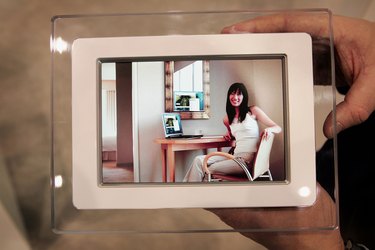
The idea of an attractive picture frame being able to play short video clips from your favorite home movies is an example of technology at its finest. The problem is figuring out how to convert your home movies or special event videos to a format that will work with the digital picture frame hardware. The need to convert video files is common place. As a result, a number of free software solutions exist to quickly handle the conversion task. However, you need to know which video file format is most common among digital picture frame manufacturers.
Convert to MJPEG-AVI with Any Video Converter
Video of the Day
Step 1
Download and install Any Video Converter (AVC).
Video of the Day
Step 2
Add the desired video clips to convert for your digital picture frame by clicking the "Add Video" button beneath the main menu.
Step 3
Insert a flash drive into an available USB port on your computer.
Step 4
Click the "Output Folder" button and select the flash drive as your destination folder.
Step 5
Select "Customized AVI Movie" from the "Profile" pull down menu in the upper right corner of the AVC program window.
Step 6
Select "mjpeg" from the "Video Codec" pull down menu located in the "Video Options" section of the customization area in the lower right corner of the program window.
Step 7
Select "Original" from the "Frame Size" pull down menu located underneath the "Video Codec" selections.
Step 8
Click the "Convert" button to output the converted file to your flash drive. When finished, insert the flash drive in your digital picture frame's USB port.
Convert to MJPEG-AVI with Super Media Encoder
Step 1
Download and install Super Media Encoder.
Step 2
Click the "M" button and select "Add Multimedia Files" from the menu to add the files you wish to convert.
Step 3
From the top three pull down menus (labeled 1, 2 and 3 respectively) select "AVI," "M-JPEG," and "MP3" respectively.
Step 4
Select "No Change" from the "Video Scale Size" section.
Step 5
Insert a flash drive into an available USB port of your computer.
Step 6
Click the "M" button and select "Output file saving management" from the menu to designate the flash drive as your output folder.
Step 7
Click the "Encode (Active Files)" to complete the conversion process. Insert the flash drive into your digital picture frame's USB port after the conversion process has been completed.
Convert to MJPEG-AVI with MediaCoder
Step 1
Add files to be converted to the MJPEG-AVI format by clicking the "+" icon.
Step 2
Insert a flash drive into your computer's USB port.
Step 3
Select the flash drive as the target folder using the "…" button of the "Output Folder" field.
Step 4
Select the "Video" tab in the lower left portion of the program window and select "Motion JPEG" from the pull down menu.
Step 5
Select the "Container" tab and choose "AVI" from the pull down menu.
Step 6
Press the "Start" icon to begin conversion. Remove the flash drive when the conversion process has been completed and place it in your digital photo frame for playback.